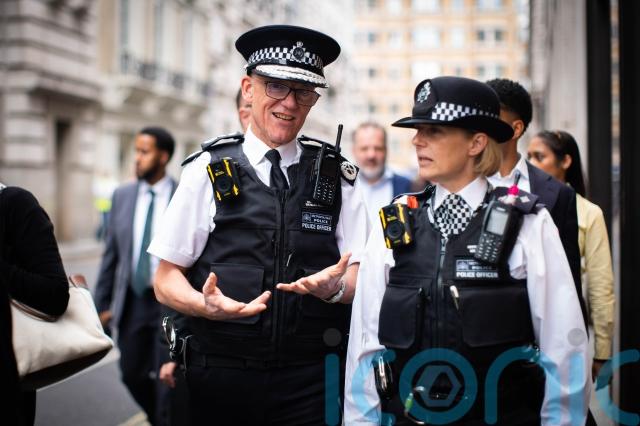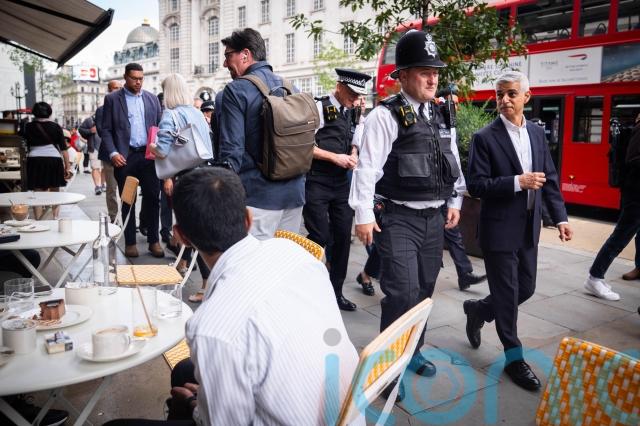
Britain’s biggest police force is set to more than double its use of live facial recognition to up to 10 deployments a week.
The move by the Metropolitan Police comes as it restructures to cover the loss of 1,400 officers and 300 staff amid budget shortages.
Part of the overhaul will also see officers moved to bulk up the force’s public order crime team, as the Met said it has faced increased demand linked to protest-related crimes in the past two years.
The squad will go from 48 to 63 officers due to a rise in the number of protests, particularly related to Israel and Palestine, as well as environmental issues.
Force chief Sir Mark Rowley told the PA news agency: “The numbers of protests have grown over the last couple of years.
“We don’t have any powers that are there to reduce the number of protests, to cancel them.
“Laws are very permissive and encouraging of protests, which is entirely understandable, and I’ve got no objection to that, but what we’ve seen, unfortunately, is a proportion of those create crime and offences.”
As part of the latest details of its restructure, the Met announced that live facial recognition will now be used up to 10 times per week across five days, up from the current four times per week across two days.
Earlier this month the Met revealed that it had made 1,000 arrests using live facial recognition to date, of which 773 had led to charge or caution.
Charlie Whelton, policy and campaigns officer at Liberty, said: “It’s incredibly concerning to see an expansion of facial recognition, especially at a time when there is a complete lack of regulation governing its use.
“Any tech which has the potential to infringe on our rights in the way scanning and identifying millions of people does needs to have robust safeguards around its use, including ensuring that proper independent oversight is in place.
“The Government must legislate now to regulate this technology, protect people’s rights, and make sure that the law on facial recognition does not get outpaced by the use.”
Sir Mark insisted that the technology is responsibly used.

“We’re only using it to look for serious offenders like wanted offenders and registered sex offenders.
“We routinely put it out there and capture multiple serious offenders in one go, many of whom have committed serious offences against women or children, or people who are wanted for armed robbery.
“It’s a fantastic piece of technology. It’s very responsibly used, and that’s why most of the public support it.”
Officers are also being moved to neighbourhood teams to deal with street crime including phone thefts, anti-social behaviour and shoplifting, with 80 moved to the team that covers the West End, a rise of 50%.
Last month, retailers warned that flagship high streets such as Oxford Street in the West End were at risk without urgent national action on crime.
While shoplifting hit a record high in 2024 with the number of offences surpassing 500,000 for the first time, High Streets UK, a group that represents 5,000 businesses, called for wider action to deal with all types of crime affecting high streets.
“The West End generates £50 billion for the UK economy,” Sir Mark said.
“It’s an enormous wealth generator. It’s important we police and protect that well.
“And we think there’s more we can do on our own and working with them.”

This will include patrolling the streets, “taking on the pickpockets”, and officers tackling gangs plotting to rob shops, he said.
Another 90 officers are moving to neighbourhood teams that cover six hotspots for robbery and theft – Brixton, Kingston, Ealing, Finsbury Park, Southwark and Spitalfields.
Mayor of London Sir Sadiq Khan said: “Nothing is more important to me than keeping Londoners safe.
“Thanks to record funding from City Hall, the West End will see a 50 per cent increase in the number of police officers on the beat and an additional 90 police officers working in new or enhanced town centre teams in hotspot areas.
“Despite years of austerity by the previous government, this is the latest example of the Met Police and I prioritising what Londoners want and delivering on our pledge to put high visibility policing at the heart of fighting crime and rebuilding community confidence and trust.
“These new and boosted Safer Neighbourhood Teams will focus on tackling antisocial behaviour, phone robbery and shoplifting in key areas.
“This fresh targeted action is happening in tandem with enhanced police and partnership work already underway in our high streets and town centres this summer.”
The Met is Britain’s largest police force, which as of February had 33,201 officers, 11,319 staff, 1,460 police community support officers and 1,127 specials.
Sir Mark warned in April that the force is facing a £260 million budget shortfall, with cuts removing the Royal Parks police and dedicated schools officers as a result.
Subscribe or register today to discover more from DonegalLive.ie
Buy the e-paper of the Donegal Democrat, Donegal People's Press, Donegal Post and Inish Times here for instant access to Donegal's premier news titles.
Keep up with the latest news from Donegal with our daily newsletter featuring the most important stories of the day delivered to your inbox every evening at 5pm.